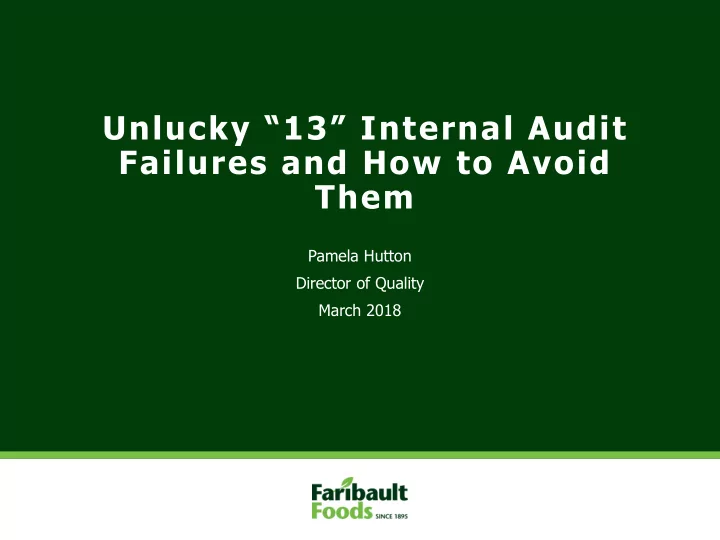

Unlucky “13” Internal Audit Failures and How to Avoid Them Pamela Hutton Director of Quality March 2018
1. Failure to Educate the Auditors and Management Failure Success • • Internal auditors are busy and a Deliver results that are clear , concise tendency exists to limit what is shared and constructive will have a great as communicating details can be time impact. consuming. • • Upper management knows a lot of Having upper management involved in information but rely upon employees the internal audit process will bridge the below them for the details. information gap.
2. No investment in training Failure Success • • Internal auditors receive an average of Training of internal auditors shall be on- 40 to 80 hours of formal training each going. Keep up to date • year business trends • future challenges • risk • • Most internal auditors have a very End to end process narrow range of specialized knowledge understanding. • • Lacking in business acumen Training should always include “soft skills.”
3. Lacking Soft Skills Failure Success • • Most often, internal auditors are Training and refresher training shall introverts and soft skills do not come always include “ soft-skills .” easy. • • Focus on the “work” of an audit and not Communication shall focus on face to the communication during the audit face communication, and not using process. technical jargon which will enable positive change.
4. Micromanagement Failure Success • • Managers of the internal audit have Managers need to focus on facilitating tendencies to want to intervene and training for the internal auditors. perform the audits and all associated tasks with the audit. • • This type of management style leads to Managers can recommend changes and employees feeling they offer no value in enhancements to current audit protocol. addition to a high attrition rate. “Leaders become great not because of their power but, because of their ability to empower others” -John Maxwell
5. Lack of planning Failure Success • • Imagine an auditor walking into your An audit plan shall include the following: • facility and he or she asks “What are we Who(auditee) • auditing today?” Scope • List of related policies, SOPs, and Work Instructions
6. Scope Creep Failure Success • • Scope creep can easily Have a very well defined occur when we flush scope for the audit before out an issue that we did beginning. Ensure the not expect to find. scope includes definition of the range of activities to be reviewed and for what time period. • Coupling the defined scope with a checklist as a working aid.
7. Not obtaining and keeping client engagement Failure Success • • Internal auditors will sometimes only Build trust within all levels of the spend time with the client/auditees organization. when they are auditing • Ask for and provide feedback after the audit.
8. Not engaging upstream and downstream employees Failure Success • • Tendency to work only with the same Diversify feedback. group where there is more comfortable level. • Involving and valuing the feedback from those who do and those who lead. “Diversity is about perspectives, experiences and skills, too” -Kelly Barrett Vice President- Internal Audit and Compliance, Home Depot
9. Phoning it in Failure Success • • Performing an audit by reviewing Dive deep refusing to accept the surface documentation and via phone calls and explanation. emails is inadequate in assessing effectiveness of programs that are used to guarantee quality and food safety. • Look, Watch, Listen.
10. Not properly using the data Failure Success • • Retrieving data from one source (ex. one Take the time to figure out the right employee), not reviewing an adequate answer rather than an answer. number of data points can lead to conclusions that are not accurate.
11. “War and Peace” Audit reports Failure Success • • Audit reports that are lengthy are not Prioritize and highlight key information. user-friendly and do not allow for continuous improvement activities to develop from the audit findings. • Develop a template audit report which allows for key information to be highlighted on the cover page.
12. Shock and Awe Findings Failure Success • • To present a significant finding that is Ensure by diligent audit and fact finding incorrect and offer no potential that your “finding” is correct. solutions. • Do not present the finding without providing guidance for a path to closure
13. Forgetting the Value Failure Success • • Auditors who “can’t see the forest for Focus on the primary object over the the trees” creates a risk to the value of hyper focusing on a detail. the audit.
Summary • As an internal auditor have you made some of these mistakes? • What changes will you make in your internal audit program to avoid these mistakes? • Use these 13 mistakes as grading criteria for your current program.
Questions
Recommend
More recommend